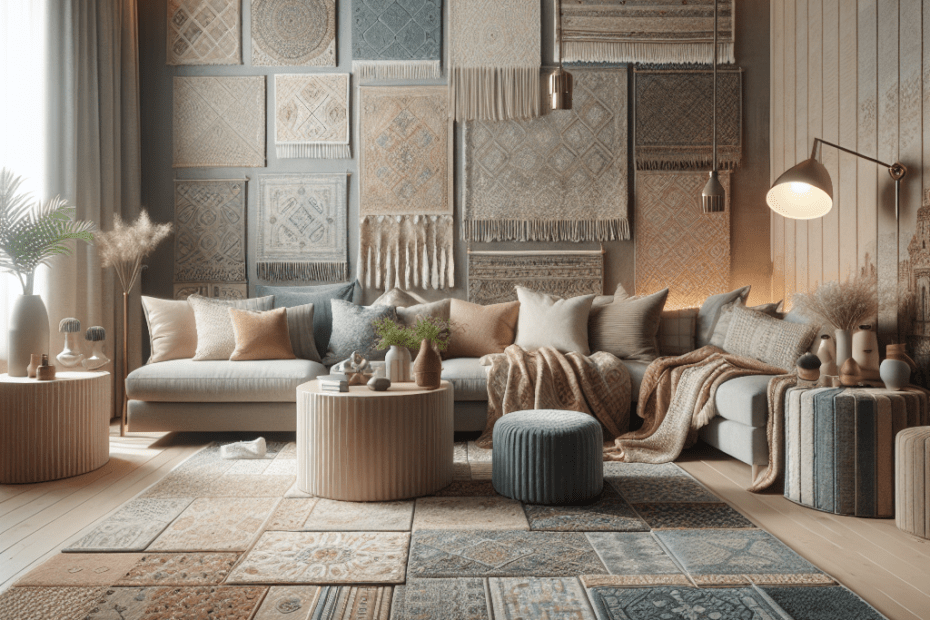Layering rugs is an innovative and stylish solution in interior design that many are utilizing to enhance the warmth, texture, and overall aesthetic of their living spaces. This technique, although widely practiced, holds untapped potential for transforming any room into a uniquely personal sanctuary.
Understanding the Basics of Layering Rugs
Layering rugs involves strategically placing multiple rugs on top of each other to add depth and interest. By mixing various textures, colors, and sizes, designers can create a visual masterpiece that ties a room together. Whether one prefers a bohemian vibe, a modern look, or a classic tapestry, layering rugs can adapt to various styles easily.
Why Layering Rugs Works So Well
- Aesthetic Appeal: Layering provides a multidimensional look that single rugs cannot achieve.
- Comfort: Adds extra softness underfoot, enhancing coziness.
- Versatility: Allows them to combine different patterns and materials, making it easy to update the look of a room without a complete overhaul.
Statistics Supporting Rug Use in Interior Design
According to the Global Home Decor Market Report, the home decor market, which includes rugs, was valued at approximately $663 billion in 2020 and is expected to grow at a CAGR of 3.9% from 2021 to 2027. This indicates a rising popularity and investment in home furnishings, including rugs, as part of decor strategies among homeowners.
Techniques for Effective Layering
Choosing Complementary Colors: Selecting a palette where the colors of the rugs complement each other helps create a cohesive look. They should opt for base rugs in neutral shades and add vibrant, patterned rugs on top.
Size Variation: To achieve the best effect, they should choose a larger, neutral rug as a base and layer one or more rugs on top that gradually decrease in size. This not only helps in visually defining areas but also draws the eye into a specific part of a room.
Contrast in Textures: Mixing different materials can add depth. They could layer a plush, high-pile rug on top of a flat-weave rug to highlight texture differences.
| Technique | Benefit |
|---|---|
| Complementary Colors | Creates a cohesive, balanced room |
| Size Variation | Defines space and draws attention |
| Texture Contrast | Adds depth and tactile interest |
Layering Rugs: Styles and Examples
Modern Minimalist: Start with a large monochrome rug and layer a smaller geometric pattern on top.
Bohemian Style: For a boho-chic space, combine a large jute rug with an antique hand-knotted Persian rug for an eclectic yet harmonious effect.
Classic Elegance: Place a simple wool rug under a richly colored oriental rug to lend a sense of timeless sophistication.
Common Mistakes in Rug Layering
Avoiding mistakes when layering rugs can greatly influence the outcome. They should be attentive to over-cluttering with too many patterns or conflicting styles, which may lead to a crowded room appearance. Additionally, not anchoring the rugs correctly can cause uneven surfaces that might become tripping hazards.
Key Takeaways
- Layering rugs can transform interior spaces with added depth and style.
- It involves careful selection of color, size, and texture for optimal results.
- The practice is part of a growing, billion-dollar home decor market.
- Common pitfalls include too many conflicting patterns and poor anchoring.
FAQ
- What is the main benefit of layering rugs?
Layering rugs adds aesthetic depth, enhances room coziness, and allows for a quick style refresh without substantial redecorating.
- Can you layer any type of rugs?
Yes, but it’s important to mix and match textures, colors, and sizes appropriately to avoid clashing designs.
- Will layering rugs make my room look smaller?
If done incorrectly, it can. By sticking to complementary colors and keeping top layers smaller, they can prevent the room from feeling cramped.
- How do I choose the colors for layering rugs?
Select a neutral base rug and build upon it with additional colors that complement the room’s decor palette.
- How often should I change my layered rug arrangement?
This depends on personal style and room usage, but they can consider tweaking it seasonally or when updating the room’s decor.
